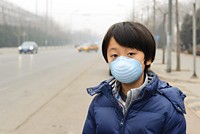Advertisement
Grab your lab coat. Let's get started
Welcome!
Welcome!
Create an account below to get 6 C&EN articles per month, receive newsletters and more - all free.
It seems this is your first time logging in online. Please enter the following information to continue.
As an ACS member you automatically get access to this site. All we need is few more details to create your reading experience.
Not you? Sign in with a different account.
Not you? Sign in with a different account.
ERROR 1
ERROR 1
ERROR 2
ERROR 2
ERROR 2
ERROR 2
ERROR 2
Password and Confirm password must match.
If you have an ACS member number, please enter it here so we can link this account to your membership. (optional)
ERROR 2
ACS values your privacy. By submitting your information, you are gaining access to C&EN and subscribing to our weekly newsletter. We use the information you provide to make your reading experience better, and we will never sell your data to third party members.
Pollution
Air pollution can cross the placenta
New research shows harmful black carbon particles embedded in fetal-side placental tissue
by Giuliana Viglione
September 23, 2019
| A version of this story appeared in
Volume 97, Issue 37

Exposure to ambient air pollution is associated with low birth weight, preterm birth, and other adverse birth outcomes. For years, scientists have puzzled over the mechanism behind these negative effects. Now, new research has uncovered an important clue: small particulate matter can cross over the placenta (Nat. Commun. 2019, DOI: 10.1038/s41467-019-11654-3). The study focused on black carbon—minute particles produced by incomplete combustion of fossil fuels and other organic substances. Black carbon particles are especially harmful because they are often coated with toxic substances like heavy metals, says Hasselt University biophysicist Hannelore Bové, who led the study. The researchers took placental biopsies from 28 mothers. When illuminated with short, fast laser pulses, the black carbon particles embedded in the placenta glowed white. Those particles were detected on both the maternal and fetal sides of all placentas sampled. The researchers also found that black carbon concentrations were higher in the placentas of women who lived in more highly polluted regions. Bové and coworkers now plan to track the development and health of the children as part of a long-term longitudinal study.





Join the conversation
Contact the reporter
Submit a Letter to the Editor for publication
Engage with us on Twitter